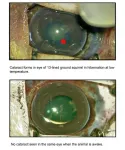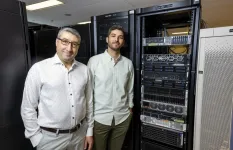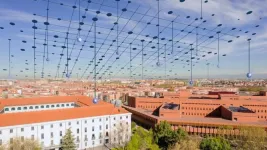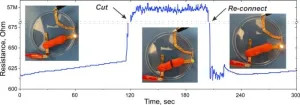(Press-News.org) NEW YORK, NY (September 18, 2024)—Columbia University will award the 2024 Louisa Gross Horwitz Prize to Scott Emr and Wesley Sundquist for discovering the ESCRT (Endosomal Sorting Complexes Required for Transport) pathway and revealing how it works.
ESCRT (pronounced “escort”) complexes deform the cell membrane and bend parts of it away from the cytoplasm, the space that houses all material inside a cell. This unique process plays an essential role in keeping cells healthy by packaging and sorting molecules, removing waste, and regulating important functions such as cell division, neuron remodeling, and immune responses. Defects in ESCRT function can lead to uncontrolled cell growth and tumor formation, contributing to cancer, neurodegeneration, and Parkinson’s disease. In addition, many viruses, including HIV, hijack ESCRT machinery to exit an infected host cell.
Scott Emr discovered the first ESCRT complex, ESCRT-I, in 2001. Emr developed a genetic strategy in yeast to search for more ESCRT proteins and, since the initial discovery, his lab has published a series of papers identifying more than 20 genes that comprise all five known ESCRT complexes. Emr also made several important discoveries about how ESCRT complexes function. He showed that lipids in the membrane act like shipping labels that can be read by ESCRT complexes to send molecules to precise destinations. Emr also found that ESCRT complexes recognize proteins that are tagged with a molecule called ubiquitin and send them to the lysozyme, a component of the cell that breaks down biomolecules. This groundbreaking discovery explained how the cell sorts proteins for destruction, a vital process in regulating cell signals and clearing waste from the cell.
Wes Sundquist’s early work focused on determining how HIV assembles in a host cell, which led to the discovery that ESCRT complexes are required for HIV replication. Sundquist showed how HIV and other enveloped viruses hijack the host cell’s ESCRT machinery to envelope their own viral components within a membrane to escape the cell and spread infection. He and his colleagues also identified new human ESCRT proteins; mapped their interactions with one another and with ubiquitin; determined the three-dimensional structures and mechanisms of several key ESCRT complexes; and contributed to our understanding of how the ESCRT pathway mediates the final step of cell division. Sundquist’s studies of HIV assembly also helped set the stage for an important new class of anti-HIV drugs.
Emr and Sundquist are the 114th and 115th winners of the Horwitz Prize, which is awarded annually by Columbia University for groundbreaking work in medical science. Of the 113 previous Horwitz Prize winners, 51 have gone on to receive Nobel Prizes.
Awardee Biographies
Scott Emr, PhD, is the Nancy M. and Samuel C. Fleming Professor Emeritus in the Department of Molecular Biology and Genetics, Cornell University, USA. Emr received his BS degree in biology from the University of Rhode Island, USA, and completed his PhD in microbiology and molecular genetics at Harvard University, USA. Emr has also held research positions at the California Institute of Technology, USA; the University of California, Berkeley, USA; the University of California, San Diego, USA; and the Howard Hughes Medical Institute, USA. He has been elected to the American Association for the Advancement of Science, European Molecular Biology Organization, American Academy of Arts and Sciences, and the National Academy of Sciences.
Wesley Sundquist, PhD, is the Samuels Professor in the Department of Biochemistry at the University of Utah, USA. Sundquist completed his BA degree in chemistry at Carleton College, USA, and obtained his PhD degree in chemistry from the Massachusetts Institute of Technology, USA. Sundquist has also held research positions at the MRC Laboratory of Molecular Biology, Cambridge, UK, and the Department of Biochemistry at the University of Wisconsin, USA. He has been elected to the American Academy of Arts and Sciences and the National Academy of Sciences.
The Louisa Gross Horwitz Prize
The Louisa Gross Horwitz Prize was established in 1967 by the late S. Gross Horwitz. It is named in honor of the donor's mother, Louisa Gross Horwitz, who was the daughter of Dr. Samuel David Gross (1805-89), a prominent Philadelphia surgeon who served as president of the American Medical Association and wrote “Systems of Surgery.” Of the 115 Horwitz Prize winners to date, 51 have gone on to receive Nobel Prizes. Most recently, 2014 Horwitz Prize winner James P. Allison, PhD, of the University of Texas MD Anderson Cancer Center shared the 2018 Nobel Prize in Physiology or Medicine with Tasuku Honjo, MD, PhD, of Kyoto University. For a list of previous Horwitz Prize awardees, please click here.
The 2024 Louisa Gross Horwitz Prize lectures and dinner will take place early next year (2025), with a date to be shared on the Horwitz website.
Visit here for more information about the Louisa Gross Horwitz Prize.
Visit here for more information about the Louisa Gross Horwitz Prize recipients.
Visit here for more information about the Louisa Gross Horwitz Prize lectures.
Columbia University Irving Medical Center
Columbia University Irving Medical Center provides international leadership in basic, preclinical, and clinical research; medical and health sciences education; and patient care. The medical center trains future leaders and includes the dedicated work of many physicians, scientists, public health professionals, dentists, and nurses at the Vagelos College of Physicians and Surgeons, the Mailman School of Public Health, the College of Dental Medicine, the School of Nursing, the biomedical departments of the Graduate School of Arts and Sciences, and allied research centers and institutions. Columbia University Irving Medical Center is home to the largest medical research enterprise in New York City and State and one of the largest faculty medical practices in the Northeast. Columbia University Irving Medical Center shares a campus with its hospital partner, NewYork-Presbyterian. For more information, visit cuimc.columbia.edu.
###
END
Scott Emr and Wesley Sundquist awarded 2024 Horwitz Prize for discovering the ESCRT pathway
2024-09-18
ELSE PRESS RELEASES FROM THIS DATE:
Versatile knee exo for safer lifting
2024-09-18
Images
A set of knee exoskeletons, built with commercially available knee braces and drone motors at the University of Michigan, has been shown to help counteract fatigue in lifting and carrying tasks. They helped users maintain better lifting posture even when tired, a key factor in defending against on-the-job injuries, the researchers say.
"Rather than directly bracing the back and giving up on proper lifting form, we strengthen the legs to maintain it," said Robert Gregg, U-M professor of robotics and corresponding author of the study in Science Robotics. "This differs from what's more commonly done in industry."
Already ...
NIH-led studies point to potential development of a cataract drug
2024-09-18
Researchers at the National Institutes of Health (NIH) and their collaborators have identified a protein, known as RNF114, that reverses cataracts, a clouding of the eye’s lens that occurs commonly in people as they age. The study, which was conducted in the 13-lined ground squirrel and rats, may represent a possible surgery-free strategy for managing cataracts, a common cause of vision loss. The study published in the Journal of Clinical Investigation.
“Scientists have long searched for an alternative to cataract surgery, which is effective, but not without risk. Lack of access to cataract surgery is a barrier to care in some ...
Artificial intelligence grunt work can be outsourced using a new blockchain-based framework developed by Concordians
2024-09-18
Tomorrow’s workplace will be run on mind-boggling amounts of data. To make sense of it all, businesses, developers and individuals will need better artificial intelligence (AI) systems, better trained AI workers and more efficient number-crunching servers.
While big tech companies have the resources and expertise to meet these demands, they remain beyond the reach of most small and medium-sized enterprises and individuals. To respond to this need, a Concordia-led international team of researchers has developed a new framework to make complex AI tasks more accessible ...
Mental health challenges faced by children with cystic fibrosis are the focus of a major, multisite study led by UB
2024-09-18
BUFFALO, N.Y. — A University at Buffalo psychiatrist who has played a critical role in getting mental health screening and treatment integrated into routine care for adults and adolescents with cystic fibrosis (CF) has been awarded $3 million from the Cystic Fibrosis Foundation to focus on the mental health of children with the disease.
Led by UB and launched this summer, the new study is an outgrowth of The International Depression Epidemiological Study (TIDES), which began in 2014 and was the largest study of mental health in adolescents and adults with CF. As a result of TIDES, ...
UC3M and Universia obtain an ENIA Chair in artificial intelligence in data economy
2024-09-18
The Universidad Carlos III de Madrid (UC3M) is one of 22 institutions that have been selected by the Ministry for Digital Transformation and the Civil Service to create an ENIA Chair to further the development of artificial intelligence (AI)-based applications. The AImpulsa UC3M-Universia Chair, as it is called, will be the only one of its kind in Spain in the area of Data Economy and will collaborate with Universia-Banco Santander, through Santander Universities.
The ENIA Chairs' objectives, which depend on the Secretary of State for Digitalisation and Artificial Intelligence of the Ministry for Digital Transformation and ...
Why petting your cat leads to static electricity
2024-09-18
Anyone who has ever pet a cat or shuffled their feet across the carpet knows that rubbing objects together generates static electricity. But an explanation for this phenomenon has eluded researchers for more than two millennia.
Now, Northwestern University scientists have finally uncovered the mechanics at play.
When an object slides, the front and back parts of that object experience different forces, researchers found. This difference in forces causes different electrical charges to build up on the front and back parts of the object. And the difference in electrical charges creates a current, leading to a light zap.
The study was published yesterday (Sept. 17) in the journal ...
UC San Diego Health maintains top quality care status by Vizient
2024-09-18
UC San Diego Health has been honored as a top performer for Vizient’s 2024 Bernard A. Birnbaum, MD, Quality Leadership Performance Award, marking the sixth consecutive year the health system has achieved this prominent distinction. This award places UC San Diego Health among the top academic medical centers in the nation, highlighting its exceptional commitment to delivering high-quality, patient-centered care. This sustained excellence recognizes the region’s only academic medical center’s mission of advancing health care standards and outcomes at the highest level.
“Being named a Vizient top performer for the sixth year in a row underscores ...
If you build it, will they come? Wildlife corridors need smarter design
2024-09-18
As human population and development continue to expand, it’s more important than ever to set aside corridors of undeveloped land where wildlife can travel safely, helping to ensure their long-term survival. However, a recent study by the University of Maryland reveals that current methods of designing and evaluating wildlife corridors may not be adequate to ensure wildlife protection, and suggests that Best Management Practices should include analyzing corridors with a smarter and more thorough framework. University researchers tested different ...
Sea surface temperature record in the southwestern Pacific: Coral colony from Fiji reveals warmest temperatures in over 600 years
2024-09-18
The sea surface temperature in the Fijian archipelago in the southwestern Pacific is now at its maximum for more than 600 years. This is the result of an international research team's evaluation of a new coral record providing further evidence for unprecedented warming in the western Pacific Ocean. According to this, the year 2022 was the warmest year in the region since 1370. The scientists used the giant coral Diploastrea heliopora colony in Fiji to obtain the data for the new reconstruction. These unique and long-lived massive corals record long-term climatic and ...
Homemade ‘play-putty’ can read the body’s electric signals, find UMass researchers
2024-09-18
AMHERST, Mass. – A new study by University of Massachusetts Amherst researchers demonstrates the effectiveness of homemade play putty at reading brain, heart, muscle and eye activity. Published in Device, the research outlines the conductive properties of this material, so-named “squishy circuits.”
“[Squishy circuits] are literally child’s play putty, that is also conductive” describes Dmitry Kireev, assistant professor of biomedical engineering and senior author on the paper.
The conductive squishy ...







